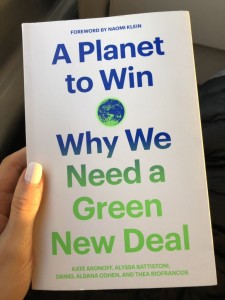Book Reviews by Eric Klinenberg, New York Review of Books, April 23, 2020
Roughly six million people across the planet participated in the Global Climate Strike last September, inspired by the sixteen-year-old Swedish activist Greta Thunberg and organized by a rising social movement of young people who ask why they should go to school every day when adults seem hell-bent on destroying their future. The demonstration, which spanned 163 countries and all seven continents, was the largest climate protest in history.
The surge of youth leadership is not the only reason the climate movement has gained momentum. Ecological crises made worse by global warming—devastating wildfires in Australia, ferocious hurricanes in the Caribbean—are unfolding faster and more violently than all but the most alarmed scientists and activists anticipated, even as recently as a decade ago. Back then, Barack Obama was in the White House, and while with one hand he patiently steered the nation toward the historic, if faltering, Paris Agreement of 2015, with the other he proudly helped the fossil fuel industry turn the US into the world’s leading oil producer. Most leaders of affluent countries acted in kind.
They went to Davos and the United Nations and preached the gospel of resiliency and sustainability. They called for a transition to renewable energy and pledged to help developing nations adapt to the treacherous conditions produced by emissions from the developed world. Then they went about business as usual, while the people and corporations they represented continued to burn through the carbon budget and threaten species of all varieties, across the planet.
Since the Paris Agreement a torrent of frightening scientific reports and catastrophic climate events has worn away the appeal of any gradual, polite approach to reform. Climate advocates have found it difficult to mobilize effectively. Their demands can come across as appeals for reducing personal consumption. Cut down on air conditioning. Don’t eat meat. Fly less. Drive less. Move into a smaller home. Thus far, appeals like this have failed to inspire the global movement that we need to combat climate change.
More and more activists, including many of the Global Climate Strike participants, see the Green New Deal (GND) as our best chance for doing so. The GND was conceived in 2007 by the New York Times columnist Thomas Friedman, but today it is most associated with New York representative Alexandria Ocasio-Cortez, who introduced it as a congressional resolution with Massachusetts senator Edward J. Markey in February 2019.
Their resolution enumerates the core concerns of the Intergovernmental Panel on Climate Change (IPCC), identifies the United States as “responsible for a disproportionate amount of greenhouse gas emissions,” states that global warming has “exacerbated systemic racial, regional, social, environmental, and economic injustices,” and warns that “climate change constitutes a direct threat to the national security of the United States”—all shocking sentences to read in a government document.
More controversially, it calls for a vast set of policy objectives for American legislators, including rapid decarbonization of the economy, which would require a full federal commitment to renewable energy systems and steep taxes on fossil fuels; an enormous public works project, with new infrastructure for housing, transit, and climate security creating millions of good jobs; economic reparations for historic discrimination against indigenous communities and people of color; the right to unionize; and a guarantee of better working conditions, including family and medical leave, paid vacations, and retirement security for all.
When the Green New Deal was introduced in Congress, the backlash was immediate, with criticisms that it was overambitious, implausible, and not worthwhile. Yet within months, every leading Democratic presidential candidate had embraced some version of the proposal. Bernie Sanders, Elizabeth Warren, Cory Booker, Amy Klobuchar, and Kamala Harris cosponsored the GND in the Senate.
In the US, Canada, and much of Europe, the GND is the rare utopian idea that feels suddenly, surprisingly, plausible: structural change that, like its predecessor, FDR’s New Deal, could actually happen. Like that remarkable legislative package, the Green New Deal aims to make infrastructure the engine of transformation. It’s predicated on the idea that protecting the earth and restoring economic opportunity require rebuilding the systems that make modern life possible.
Three new books relate to our challenges:
1. On Fire: The (Burning) Case for a Green New Deal by Naomi Klein, Simon and Schuster, 309 pp., $27.00; $18.00 (paper)
2. This Land Is Our Land: The Struggle for a New Commonwealth by Jedediah Purdy, Princeton University Press, 164 pp., $19.95
3. A Planet to Win: Why We Need a Green New Deal by Kate Aronoff, Alyssa Battistoni, Daniel Aldana Cohen, and Thea Riofrancos, (foreword by Naomi Klein), Verso, 194 pp., $19.95 (paper)
These books argue that nothing less than a Green New Deal will allow future generations to live well on this planet. Purdy’s is a soulful work of political theory based on a lecture he delivered at the New York Institute for the Humanities in 2018.
Klein’s is a collection of incendiary essays, speeches, and dispatches from her visits to Puerto Rico, the Vatican, and the Great Barrier Reef— some of the front lines of the climate movement — that were originally published in progressive outlets like The Guardian and The Intercept over the past ten years.
A Planet to Win, which includes a foreword by Klein, offers a blueprint for how a GND could transform the global political economy and an argument that nothing short of this will stave off a climate crisis.
See more of these book reviews tomorrow.


{ 1 comment… read it below or add one }
Please note that the second book is authored by Jed Purdy, from Chloe, WV. He is now a Professor of Law at Columbia University.
I knew him some years ago when he was a
student intern with the WV Environmental Council.
(Local Boy does good!)
Jim Kotcon, Monongalia County, WV